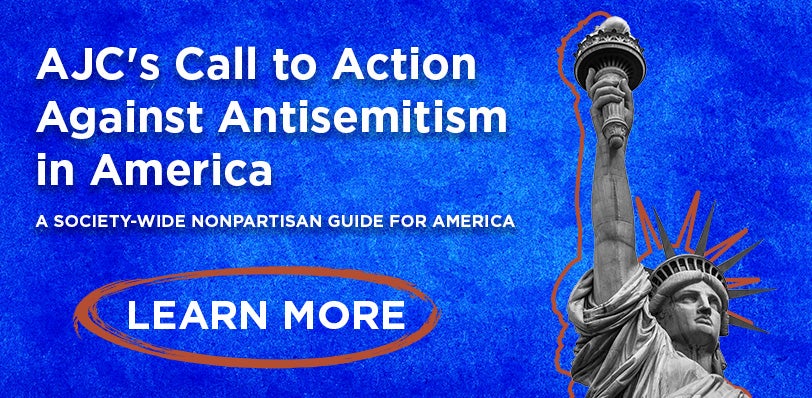What is antisemitism and how to best understand it
A guide from American Jewish Committee (AJC) to understanding what is antisemitism and where it comes from.
Understanding Antisemitism
To counter antisemitism, one must understand it. AJC's State of Antisemitism in America 2023 Report revealed that almost one-third (30%) of Americans are not even familiar with what antisemitism is. First, to understand the hatred of Jews, one needs to know who Jews are.
Who are Jews? Jews account for 0.2% of the world’s population—only 15.7 million people. The largest Jewish community in the world is in Israel, with over 7 million Jews. In the United States, there are 6.3 million Jews, accounting for only 2.4% of the population. Jews are more than a religious group: They reflect diverse ethnic, racial, and national characteristics while exhibiting a strong sense of group identity. Jews have continuously lived in the land of Israel since Biblical times, and today half of the world’s Jewish population are citizens of the State of Israel. Jews span the full political and socio-economic spectrum. The Jewish people include Ashkenazi Jews descended from Eastern Europe, Black Jews from Ethiopia, Brown Jews from India, and Mizrahi and Sephardi Jews from North Africa, the Middle East, Turkey, and Iran. Jews by choice (those who convert to Judaism) add to this diversity. Given this diversity, characterizing Jews as only “white” and “privileged” ignores history and present reality.
What is antisemitism? For governments, law enforcement agencies, and others who have a practical need to identify and respond to antisemitism, the best tool is the International Holocaust Remembrance Alliance (IHRA) Working Definition of Antisemitism, which defines antisemitism as “a certain perception of Jews, which may be expressed as hatred toward Jews.” It also includes practical examples to determine whether something is antisemitic, such as discrimination and hatred of Jews, conspiracy theories, Holocaust denial and distortion, and antisemitism related to Israel. Internationally recognized as the authoritative definition, the IHRA Working Definition has been adopted by more than 1,000 bodies, including more than 40 countries and multilateral organizations such as the European Union and the Organization of American States. It informs the U.S. State Department’s work on global antisemitism and guides the U.S. Department of Education efforts to address antisemitism on college campuses. Scores of universities, sports teams and leagues, states, and local governments have formally adopted it.
Where does antisemitism come from? Antisemitism is often described as the world’s oldest hatred. The historical foundation of antisemitism is Christian anti-Judaism, in which Jews were accused of killing Jesus Christ (deicide charge), kidnapping and murdering Christian children to use their blood in rituals (blood libel), and spreading the Black Plague through common drinking wells (“poisoning the well”). As European Jews were emancipated in the 19th and 20th centuries, they continued to be blamed for “why things went wrong.” Nefarious publications such as the fictitious Protocols of the Elders of Zion, centered on invented conspiracies of Jewish power, wealth, and plots to control governments and economies. The myth of Jewish control also featured heavily in Nazi propaganda, which viewed Jews as racially impure and the cause of society’s ills. In modern times, antisemitism against the Jewish collective continues to manifest as hatred against the Jewish state, Israel, or when Israel is viewed as the source of evil in the world, in the same ways antisemites viewed Jews historically.
The sustained antisemitism American Jewish communities have experienced over the past several years, while part of a global rise, has distinctive American elements and must be addressed within an American historical context. In the United States, while antisemitic episodes can be traced back to the arrival of Jews in America in the 17th and 18th centuries, with a particular spike following increased Jewish immigration during the turn of the 20th century, contemporary antisemitism in the U.S. looks different.1 Today, there are many sources making it difficult to pinpoint: antisemitism stems from the far-right, including white supremacy, white nationalism, and neo-Nazi antisemitism; the far-left, arising from identity-based politics or anti-Israel antisemitism, including denying Israel’s right to exist; religious extremism, including Islamist extremism and factions of some religious sects such as Black Hebrew Israelites and Nation of Islam; and from segments of minority communities, whether as a form of scapegoating or seeing Jews as an outgroup or a competitive threat, including competition of victimhood. AJC’s Translate Hate glossary includes tropes and phrases that are reused and recycled, often unknowingly. More information on the origins of antisemitism is available here.
Is criticism of Israel antisemitic? Political protest is an essential part of democracy, and criticism of Israel similar to that leveled against any other country is legitimate. However, it is antisemitic to target or attack Jews and Jewish institutions as a response to Israeli policies or actions. Across the globe, particularly since Hamas’ attacks against Israel on October 7, 2023, antisemitic incidents are occurring at an alarmingly high frequency and with a broad geographic reach. Anti-Jewish hate has surged roughly 400% in the U.S. since October 7, on top of already heightened figures. These examples—which occurred amidst and after Hamas’ horrific terrorist attacks on October 7, 2023, and the subsequent war—show when anti-Israel statements and actions are antisemitic.2


